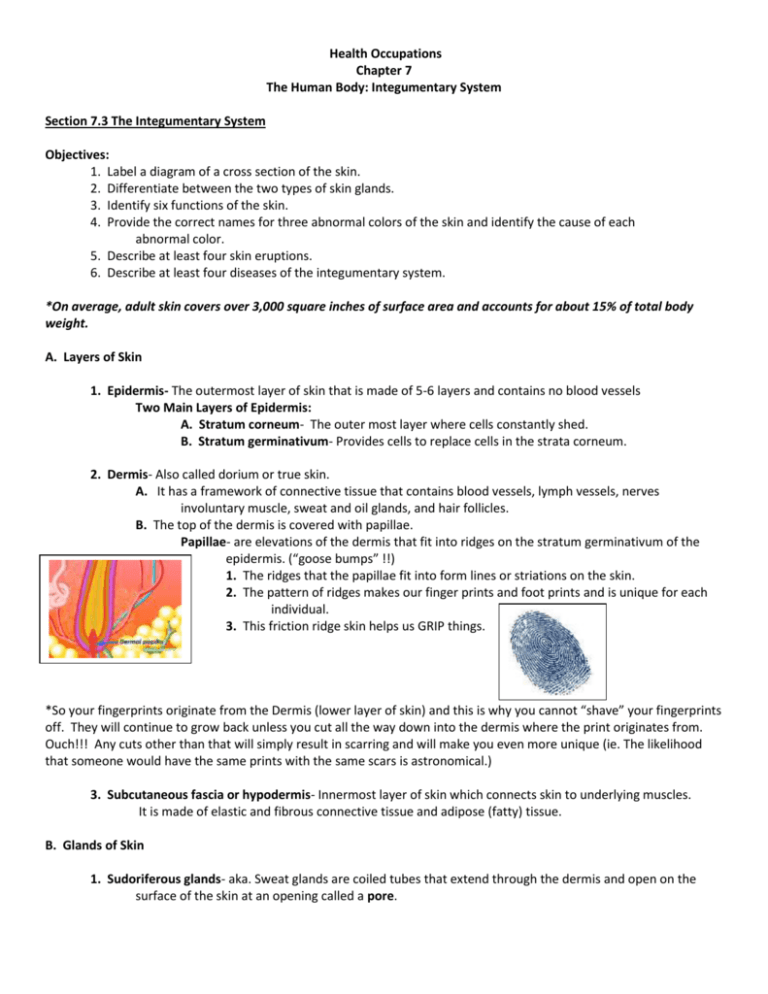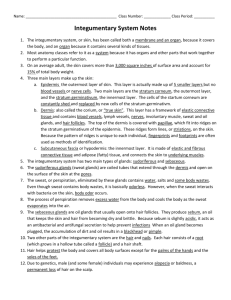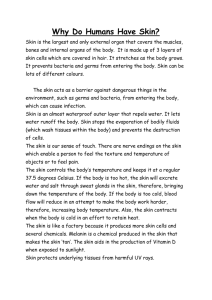Health Occupations Chapter 7 The Human Body: Integumentary
advertisement

Health Occupations Chapter 7 The Human Body: Integumentary System Section 7.3 The Integumentary System Objectives: 1. Label a diagram of a cross section of the skin. 2. Differentiate between the two types of skin glands. 3. Identify six functions of the skin. 4. Provide the correct names for three abnormal colors of the skin and identify the cause of each abnormal color. 5. Describe at least four skin eruptions. 6. Describe at least four diseases of the integumentary system. *On average, adult skin covers over 3,000 square inches of surface area and accounts for about 15% of total body weight. A. Layers of Skin 1. Epidermis- The outermost layer of skin that is made of 5-6 layers and contains no blood vessels Two Main Layers of Epidermis: A. Stratum corneum- The outer most layer where cells constantly shed. B. Stratum germinativum- Provides cells to replace cells in the strata corneum. 2. Dermis- Also called dorium or true skin. A. It has a framework of connective tissue that contains blood vessels, lymph vessels, nerves involuntary muscle, sweat and oil glands, and hair follicles. B. The top of the dermis is covered with papillae. Papillae- are elevations of the dermis that fit into ridges on the stratum germinativum of the epidermis. (“goose bumps” !!) 1. The ridges that the papillae fit into form lines or striations on the skin. 2. The pattern of ridges makes our finger prints and foot prints and is unique for each individual. 3. This friction ridge skin helps us GRIP things. *So your fingerprints originate from the Dermis (lower layer of skin) and this is why you cannot “shave” your fingerprints off. They will continue to grow back unless you cut all the way down into the dermis where the print originates from. Ouch!!! Any cuts other than that will simply result in scarring and will make you even more unique (ie. The likelihood that someone would have the same prints with the same scars is astronomical.) 3. Subcutaneous fascia or hypodermis- Innermost layer of skin which connects skin to underlying muscles. It is made of elastic and fibrous connective tissue and adipose (fatty) tissue. B. Glands of Skin 1. Sudoriferous glands- aka. Sweat glands are coiled tubes that extend through the dermis and open on the surface of the skin at an opening called a pore. A. Sudoriferous glands function to eliminate sweat or perspiration that contains water, salts, and some body wastes. B. Sweat contains body wastes and is basically odorless. When sweat interacts with bacteria on skin body odor occurs. C. The process of perspiration removes excess water from the body and cools body as sweat evaporates into the air. 2. Sebaceous glands- aka. Oil glands which usually open onto a hair follicle. A. Sebaceous glands produce oil called sebum 1. Sebum keeps hair from becoming dry and brittle and is slightly acidic so it acts as an antibacterial and antifungal secretion to help prevent infections. 2. A blackhead or pimple occurs when oil glands become plugged with dirt and oil. C. Other Parts of the Integumentary System 1. Hair- Consists of a hair shaft and a root that grows in a hollow tube called a follicle. A. Hair helps protect the body and covers all body surfaces except the palms of the hands and feet. B. Alopecia- aka. Baldness is a genetic condition that is common in men, but can also occur in women and involves the permanent loss of hair on the scalp. 2. Nails- are made of dead keratinized epidermal epithelial cells, which are packed closely together to form a thick, dense surface. A. Nails function to protect the fingers and toes from injury. B. Nail cells form in the nail bed and will continue to regrow as long as the nail bed is not damaged. D. Functions of the Integumentary System 1. Protection- It serves as a barrier for sun’s ultraviolet rays, protects against invasion of pathogens or germs, and holds moisture in preventing deep tissues from drying out. 2. Sensory perception- Nerves present in the skin responds to pain, pressure, temperature, and touch sensations. 3. Regulation of body temperature- Blood vessels in the skin help retain or release heat. A. When blood vessels dilate, they allow excess heat to escape through the skin. B. When blood vessels constrict, they retain heat. C. Sudoriferous (sweat) glands also help cool the body through evaporation of perspiration. 4. Storage- skin has tissues for temporary storage of fat, glucose (sugar), water, vitamins, and salts. A. Stores adipose tissue in subcutaneous fascia, which is a source of energy. 5. Absorption- Certain substances are absorbed through the skin. This is called transdermal absorption. Ex. Medications for motion sickness, nitroglycerine for heart trouble, and nicotine patches to help a person quit smoking. 6. Excretion- Helps the body eliminate salt, wastes, and excess water through the act of perspiration. 7. Production- Skin helps in production of vitamin D by using the ultraviolet rays from the sun to form an initial molecule of vitamin D that matures in the liver. E. Skin Color 1. Pigmentation- skin color is inherited and determined by pigments in epidermis. A. Melanin- is a brownish-black pigment produced in the epidermis by specialized cells called melanocytes. B. Everyone has the same number of melanocytes. Genes present in each racial group determine the amount of melanin produced. C. Melanin causes a black, brown, or yellowish skin tint depending on racial origin and the amount of melanin produced. D. Ultraviolet light activates melanocytes to produce more melanin to protect and tan the skin. E. Small concentrated areas of melanin pigment form freckles. F. Carotene- yellowish-red pigment that also helps determine skin color. 2. Albino- absence of color pigments producing skin that has a pinkish tint, hair that is pale yellow or white, and eyes that are red in color and very sensitive to light. 3. Abnormal colorsA. Erythema- reddish color caused by burns or a congestion of blood in vessels. B. Jaundice- yellowish discoloration that can indicate the presence of bile in blood as a result of liver or gallbladder disease. Jaundice is also seen in certain diseases that involve destruction of red blood cells. C. Cyanosis- bluish discoloration caused by insufficient oxygen and is commonly associated with heart, lung, and circulatory diseases. D. Gray or brown discoloration- signs of chronic poisonings. F. Skin Eruptions1. Macules (macular rash)- flat spots on the skin. Ex. Freckles 2. Papules (popular rash)- firm raised areas as in pimples and stages of chicken pox. 3. Vesicles- blisters or sacs full of fluid seen in some stages of chicken pox. 4. Pustules- sacs filled with pus. Ex. Acne or pimples 5. Crusts- areas of dried pus and blood commonly called scabs. 6. Wheals- itchy elevated areas with an irregular shape often seen in hives and insect bites. 7. Ulcer- Deep loss of skin surface that may extend into the dermis and may cause periodic bleeding and formation of scars. G. Diseases and abnormal conditions1. Acne vulgaris- Inflammation of sebaceous glands usually occurring during adolescence as a result of hormonal changes and increased sebum. A. Symptoms- include papules, pustules, and blackheads all occurring when hair follicle becomes blocked with dirt, cosmetics, excess oil and/ or bacteria. B. Treatment- frequent thorough washing of skin, avoid creams and heavy makeup, antibiotics or vitamin A ointments, ultraviolet light treatments. 2. Athlete’s foot- contagious fungal infection usually on feet. A. Symptoms- itchy skin, blisters, and cracks which may turn in to open sores. B. Treatment- antifungal medication, keep area dry and clean. 3. Cancer- has many causes and occurs in different forms. A. Causes/ indicators1. A mole that changes in color, shape, size or texture 2. Bleeding or itching of a mole. 3. Exposure to the sun, prolonged use of tanning beds. 4. Irritating chemicals or radiation. B. Treatments involve surgical removal of the cancer, radiation, and/or chemotherapy. C. Types 1. Basal cell carcinoma- cancer of the basal cells in the epidermis of the skin which grows slowly and usually does not spread. Lesions can be pink to yellow-white and are usually smooth with a depressed center having an irregular –shaped border. 2. Squamous cell carcinoma- affects the thin cells of the epithelium but can spread quickly to other areas of the body. Lesions start as small, firm, red flat sores that later scale or crust. Sores that do not heal are frequently squamous cell carcinomas. 3. Malignant melanoma-develops in the melanocytes of the epidermis and is the most dangerous type of skin cancer. Lesions can be brown, black, pink, or multicolored. They are usually flat or raised slightly, asymmetric and irregular or notched on the edges. 4. Dermatitis- Inflammation of the skin. A. Caused by any substance that irritates the skin such as an allergic reaction to detergents, cosmetics, pollen or certain foods. B. Contact dermatitis- is caused by contact with poison ivy, poison sumac, or poison oak. C. Symptoms of dermatitis include dry skin, erythema, itching, edema (swelling), macular-papular rashes, scaling. D. Treatments include eliminating the cause of the allergens, use of anti-inflammatory ointments, antihistamines and/ or steroids. 5. Eczema- noncontagious inflammatory skin disorder. A. Caused by a reaction to allergen or irritant: diet, cosmetics, soaps, medications, and or emotional stress. B. Symptoms include dryness, erythema, edema, itching, vesicles, crusts, and scaling. C. Treatment includes removing the irritant and applying corticosteroids. 6. Impetigo- highly contagious streptococcal or staphylococcal skin infection. A. Symptoms include dryness, erythema, oozing vesicles, pustules, formation of yellow crust B. Treatment includes washing lesions with soap and water, keep dry, use topical and oral antibiotics. 7. Psoriasis- Chronic, noncontagious, inherited skin disease characterized by periods of exacerbations (symptoms present) and remission (symptoms decrease or disappear). A. Although the cause is hereditary, symptoms tend to be exacerbated by stress, cold weather, sunlight, pregnancy, and endocrine changes. B. Symptoms include red thick areas covered with white or silver scales. C. Treatment- NO CURE. CHRONIC CONDITION. Coal tar, cortisone ointments, ultraviolet light, and removal of scales can help with symptoms. 8. Ringworm- highly contagious fungus infection of skin or scalp. A. Symptoms include flat or raised circular area with clear central area surrounded by an itchy, scaly, or crusty outer ring. B. Treatment includes oral and topical antifungal medications. 9. Verrucae or warts- viral infection of the skin A. Symptoms include the formation of rough, hard, elevated, rounded surface on the skin. B. Plantar warts- usually occur at pressure points on the soles of the feet. C. Treatment includes removal with electricity, liquid nitrogen, acid, chemicals, or laser. Some disappear spontaneously. Application: Do you know… 1. What is the function of the sudoriferous glands? 2. What is the function of the sebaceous glands? 3. Name six functions of the integumentary system. 4. What is erythema? 5. What is jaundice? 6. What is cyanosis? 7. What is the difference between macules and papules? 8. What is the difference between vesicles and pustules? 9. What is dermatitis? 10. What is impetigo? 11. What is eczema? 12. What is psoriasis? Health Occupations Chapter 7 The Human Body: Integumentary System Section 7.3 The Integumentary System Objectives: 1. Label a diagram of a cross section of the skin. 2. Differentiate between the two types of skin glands. 3. Identify six functions of the skin. 4. Provide the correct names for three abnormal colors of the skin and identify the cause of each abnormal color. 5. Describe at least four skin eruptions. 6. Describe at least four diseases of the integumentary system. *On average, adult skin covers over 3,000 square inches of surface area and accounts for about 15% of total body weight. A. Layers of Skin 1. ____________________________- The outermost layer of skin that is made of 5-6 layers and contains no blood vessels Two Main Layers of Epidermis: A. Stratum corneum- ____________________________________________________________ B. Stratum germinativum- ________________________________________________________ 2. Dermis- _______________________________________________________________ A. It has a framework of connective tissue that contains blood vessels, lymph vessels, nerves involuntary muscle, sweat and oil glands, and hair follicles. B. The top of the dermis is covered with papillae. ______________________- are elevations of the dermis that fit into ridges on the stratum germinativum of the epidermis. (“goose bumps” !!) 1. ___________________________________________________________________ 2. The pattern of ridges makes our finger prints and foot prints and is unique for each individual. 3. ___________________________________________________ *So your fingerprints originate from the Dermis (lower layer of skin) and this is why you cannot “shave” your fingerprints off. They will continue to grow back unless you cut all the way down into the dermis where the print originates from. Ouch!!! Any cuts other than that will simply result in scarring and will make you even more unique (ie. The likelihood that someone would have the same prints with the same scars is astronomical.) 3. ________________________________________- Innermost layer of skin which connects skin to underlying muscles. - It is made of elastic and fibrous connective tissue and______________________________. B. Glands of Skin 1. ______________________________________- aka. _______________________are coiled tubes that extend through the dermis and open on the surface of the skin at an opening called a _________________. A. Sudoriferous glands function to _______________________________________________that contains ______________________, ___________________, and ________________________. B. Sweat contains body wastes and is______________________________. When sweat interacts with ______________________________on skin ______________________________occurs. C. The process of perspiration _________________________________from the body and __________________________as sweat evaporates into the air. 2. __________________________________- aka. __________________________ which usually open onto a hair follicle. A. Sebaceous glands produce oil called_______________________________ 1. Sebum keeps hair from becoming ________________________and is slightly acidic so it acts as an _____________________________________________secretion to help prevent infections. 2. ______________________________occurs when oil glands become plugged with dirt and oil. C. Other Parts of the Integumentary System 1. ____________________- Consists of a hair shaft and a root that grows in a hollow tube called a follicle. A. Hair helps protect the body and covers all body surfaces except the palms of the hands and feet. B. ______________________________- aka. _____________________is a genetic condition that is common in men, but can also occur in women and involves the permanent loss of hair on the scalp. 2. _______________________- are made of dead keratinized epidermal epithelial cells, which are packed closely together to form a thick, dense surface. A. ____________________________________________________________ B. Nail cells form in the _____________________and will continue to regrow as long as the nail bed is ___________________________. D. Functions of the Integumentary System 1. _____________________________ - It serves as a barrier for_________________________________, protects against invasion of______________________________________, and holds moisture in preventing deep tissues from drying out. 2. ____________________________________- Nerves present in the skin responds to ___________________, ______________________, _________________________, and ____________________________. 3. ______________________________________- Blood vessels in the skin help retain or release heat. A. When blood vessels dilate,____________________________________________________________. B. When blood vessels constrict, ________________________________________. C. Sudoriferous (sweat) glands also help cool the body through_________________________________. 4. ___________________________- skin has tissues for temporary storage of fat, glucose (sugar), water, vitamins, and salts. -Stores adipose tissue in subcutaneous fascia, which is a_______________________________________. 5. _________________________- Certain substances are absorbed through the skin. This is called ____________________________________________. Ex.________________________________________, __________________________for heart trouble, and ______________________________________to help a person quit smoking. 6. __________________________- Helps the body eliminate ___________________________, ____________________________, and ___________________________through the act of perspiration. 7. ________________________________- Skin helps in production of __________________________by using the ultraviolet rays from the sun to form an initial molecule of vitamin D that matures in the liver. E. Skin Color 1. ______________________________- skin color is inherited and determined by pigments in epidermis. A. ______________________- is a brownish-black pigment produced in the epidermis by specialized cells called _______________________________. B. Everyone has the same number of___________________________________. __________________ present in each racial group determine the amount of melanin produced. C. Melanin causes a _______________________, _______________________, or _______________ skin tint depending on racial origin and the amount of melanin produced. D. __________________________activates melanocytes to produce more melanin to protect and tan the skin. E. Small concentrated areas of melanin pigment form ____________________________. F. ___________________________- yellowish-red pigment that also helps determine skin color. 2. _______________________________- absence of color pigments producing skin that has a ______________________tint, hair that is_________________________________, and eyes that are ____________in color and very sensitive to light. 3. Abnormal colorsA. _________________________- _____________________color caused by burns or a congestion of blood in vessels. B. _______________________- ______________________discoloration that can indicate the presence of__________________ in blood as a result of liver or gallbladder disease. Jaundice is also seen in certain diseases that involve destruction of red blood cells. C. _________________________- ________________________discoloration caused by insufficient oxygen and is commonly associated with heart, lung, and circulatory diseases. D. ________________________________________- signs of chronic poisonings. F. Skin Eruptions1. Macules (macular rash)-______________________________________________. Ex. ___________________ 2. ________________________________- firm raised areas as in pimples and stages of chicken pox. 3. Vesicles- ___________________________________________________seen in some stages of chicken pox. 4. Pustules- ____________________________________________. Ex. _____________________________ 5. ________________________- areas of dried pus and blood commonly called ______________________. 6. ______________________- itchy elevated areas with an irregular shape often seen in _______________________ and _______________________. 7. _______________________- Deep loss of ______________________________that may extend into the __________________and may cause periodic bleeding and formation of scars. G. Diseases and abnormal conditions1. __________________________- Inflammation of sebaceous glands usually occurring during adolescence as a result of _________________________________and _____________________________________. A. Symptoms- ____________________________, ___________________________, and ___________________________ all occurring when hair follicle becomes blocked with dirt, cosmetics, excess oil and/ or bacteria. B. Treatment- frequent thorough washing of skin, avoid creams and heavy makeup, antibiotics or vitamin A ointments, ultraviolet light treatments. 2. Athlete’s foot- ________________________________usually on feet. A. Symptoms- itchy skin, blisters, and cracks which may turn in to open sores. B. Treatment- antifungal medication, keep area dry and clean. 3. ______________- has many causes and occurs in different forms. A. Causes/ indicators1. A mole that changes in __________________, ___________________, & ________________. 2. Bleeding or itching of a ____________________. 3. Exposure to the sun, prolonged use of tanning beds. 4. Irritating chemicals or radiation. B. Treatments involve surgical removal of the cancer, radiation, and/or chemotherapy. C. Types 1. _____________________________- cancer of the basal cells in the epidermis of the skin which grows slowly and usually does not spread. Lesions can be pink to yellow-white and are usually smooth with a depressed center having an irregular –shaped border. 2. _____________________________- affects the thin cells of the epithelium but can spread quickly to other areas of the body. Lesions start as small, firm, red flat sores that later scale or crust. Sores that do not heal are frequently squamous cell carcinomas. 3. _____________________________-develops in the melanocytes of the epidermis and is the most dangerous type of skin cancer. Lesions can be brown, black, pink, or multicolored. They are usually flat or raised slightly, asymmetric and irregular or notched on the edges. 4. Dermatitis-__________________________________________________. A. Caused by ______________________________________________________such as an allergic reaction to detergents, cosmetics, pollen or certain foods. B. ___________________________- is caused by contact with poison ivy, poison sumac, or poison oak. C. Symptoms of dermatitis include dry skin, erythema, itching, edema (swelling), macular-papular rashes, scaling. D. Treatments include eliminating the cause of the allergens, use of anti-inflammatory ointments, antihistamines and/ or steroids. 5. Eczema-_____________________________________________________________________________. A. Caused by a reaction to allergen or irritant: diet, cosmetics, soaps, medications, and or emotional stress. B. Symptoms include dryness, erythema, edema, itching, vesicles, crusts, and scaling. C. Treatment includes removing the irritant and applying corticosteroids. 6. Impetigo-_____________________________________________________________________________. A. Symptoms include dryness, erythema, oozing vesicles, pustules, formation of yellow crust B. Treatment includes washing lesions with soap and water, keep dry, use topical and oral antibiotics. 7. ______________________________- Chronic, noncontagious, inherited skin disease characterized by periods of exacerbations (_____________________________) and remission (________________________________). A. Although the cause is hereditary, symptoms tend to be exacerbated by stress, cold weather, sunlight, pregnancy, and endocrine changes. B. Symptoms include red thick areas covered with white or silver scales. C. Treatment- NO CURE. CHRONIC CONDITION. Coal tar, cortisone ointments, ultraviolet light, and removal of scales can help with symptoms. 8. _________________________________- highly contagious fungus infection of skin or scalp. A. Symptoms include flat or raised circular area with clear central area surrounded by an itchy, scaly, or crusty outer ring. B. Treatment includes oral and topical antifungal medications. 9. Verrucae or warts- ___________________________________________ A. Symptoms include the formation of rough, hard, elevated, rounded surface on the skin. B. Plantar warts- usually occur at ________________________________________________________. C. Treatment includes removal with electricity, liquid nitrogen, acid, chemicals, or laser. Some disappear spontaneously. HYPODERMIS ***COMEDO MEANS BLOCKAGE.








